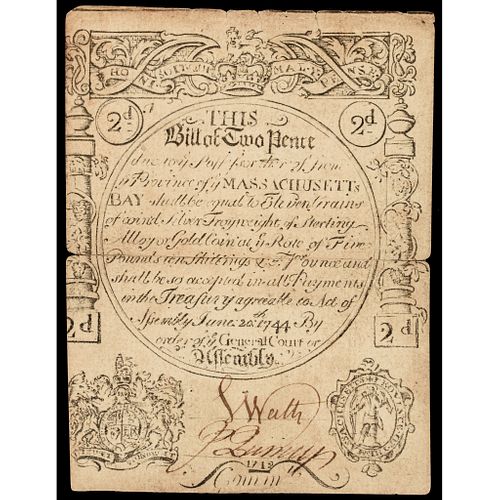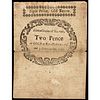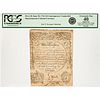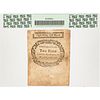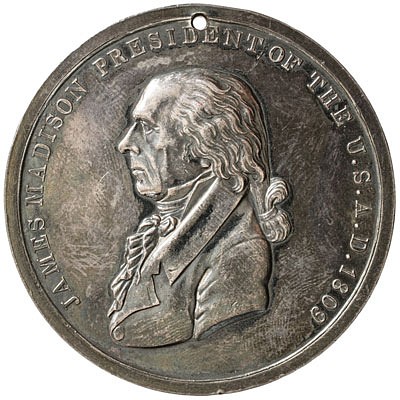Colonial Currency Massachusetts Bay June 20, 1744 Two Pence CFT PCGS graded EF40
Lot 34
Categories
Estimate:
$4,000 - $6,000
Absentee vs Live bid
Two ways to bid:
- Leave a max absentee bid and the platform will bid on your behalf up to your maximum bid during the live auction.
- Bid live during the auction and your bids will be submitted real-time to the auctioneer.
Bid Increments
| Price | Bid Increment |
|---|---|
| $0 | $10 |
| $200 | $20 |
| $300 | $25 |
| $500 | $50 |
| $1,000 | $100 |
| $2,000 | $200 |
| $3,000 | $250 |
| $5,000 | $500 |
| $10,000 | $1,000 |
| $20,000 | $2,000 |
| $30,000 | $2,500 |
| $50,000 | $5,000 |
| $100,000 | $10,000 |
| $200,000 | $20,000 |
| $300,000 | $25,000 |
| $500,000 | $50,000 |
About Auction
By Early American History Auctions
Jul 24, 2021
Set Reminder
2021-07-24 12:00:00
2021-07-24 12:00:00
America/New_York
Bidsquare
Bidsquare : A Revolutionary Numismatic Auction
https://www.bidsquare.com/auctions/early-american-history-auctions/a-revolutionary-numismatic-auction-7186
A Revolutionary Numismatic Auction Early American History Auctions auctions@earlyamerican.com
A Revolutionary Numismatic Auction Early American History Auctions auctions@earlyamerican.com
- Lot Description
Massachusetts Currency
June 20, 1744 Province of Massachusetts Bay Two Pence Extremely Rare Lowest Denomination CFT. PCGS EF-40
Province of Massachusetts Bay. June 20, 1744. Two Pence. Contemporary Counterfeit. PCGS graded Extremely Fine-40.
Fr. MA-120CFT. This early Province of Massachusetts Bay "Tall" Bill type is known in both genuine and counterfeit form. "Signed" by S.(amuel) Watts and J. Quincy above "1742 Commtt(ee)" at bottom center. Two Genuine notes and only one Contemporary Counterfeit were offered in the May 2004 Stack's Ford Collection, Part III. Lot 532 was the sole counterfeit type, graded Very Fine with print weakness and fold splits, selling for $6,612 nearly two decades ago. An intricate design is used with a circular cartouche for the text and ornate details at the entablature, which is supported by vine covered columns. At the lower left is the British Royal Arms, and at the lower right, the Massachusetts Arms displaying the Native American Wampanoag Indian Chief Massasoit standing within at center. The printed back shows the denomination within an interesting "bracelet" design cartouche. The plate details are a bit weak and the note is clearly a contemporary counterfeit. the holder has noted; apparent center split repaired; small edge tears; paper toned; pinholes. A strip of old archival glassine tape is across the horizontal centerfold as reinforcement and appears to be lifting thus easily removable. The currently offered note appears superior in quality to the Ford example and is Extremely Fine-40 PCGS grade attests to its among the finest known status. Also, as clearly seen in our photographs this rare note has considerable eye appeal, especially on its face side. Ex: Eric P. Newman Numismatic Education Society.
Massasoit, (born c. 1590, near present Bristol, Rhode Island, U.S.-died 1661, near Bristol), Wampanoag Indian chief who throughout his life maintained peaceful relations with English settlers in the area of the Plymouth Colony, Massachusetts.
Massasoit was the Grand Sachem (intertribal chief) of all the Wampanoag Indians, who inhabited parts of present Massachusetts and Rhode Island, particularly the coastal regions. In March 1621-several months after the landing of the Mayflower at Plymouth-Massasoit journeyed to the colony with his colleague Samoset, who had already made friendly overtures to the Pilgrims there.
Convinced of the value of a thriving trade with the newcomers, Massasoit set out to ensure peaceful accord between the races-a peace that lasted as long as he lived. In addition, he and his fellow Indians shared techniques of planting, fishing, and cooking that were essential to the settlers' survival in the wilderness. When Massasoit became dangerously ill in the winter of 1623, he was nursed back to health by the grateful Pilgrims. The colonial leader, Governor Edward Winslow, was said to have traveled several miles through the snow to deliver nourishing broth to the chief.
Massasoit was able to keep the peace for many decades, but new waves of land-hungry Europeans created tension as the Indians' native land was steadily taken over by the whites. When he died, goodwill gradually dissolved, culminating in the bloody King Philip's War (1675), led by Massasoit's second son.
- Shipping Info
-
Early American provides in-house worldwide shipping. Please contact us directly if you have questions about your specific shipping requirements.
-
- Buyer's Premium



 EUR
EUR CAD
CAD AUD
AUD GBP
GBP MXN
MXN HKD
HKD CNY
CNY MYR
MYR SEK
SEK SGD
SGD CHF
CHF THB
THB